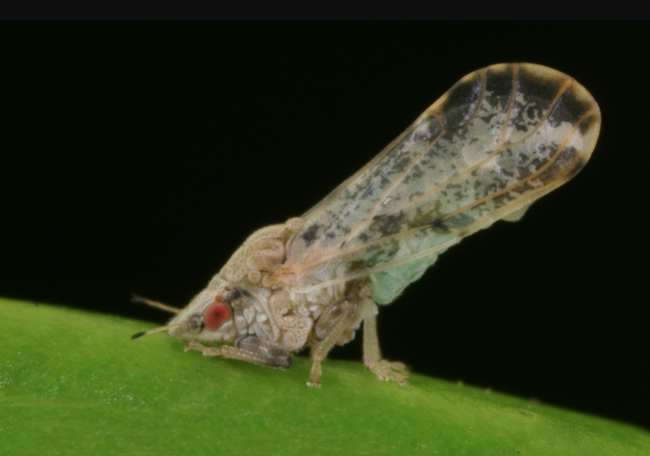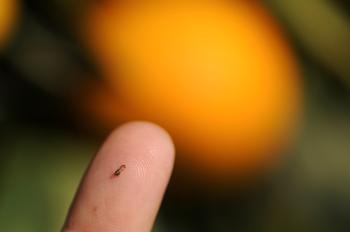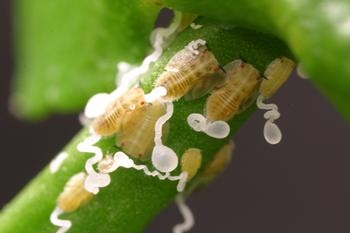Posts Tagged: Asian citrus psyllid
ACP Training - English and Spanish
Save the Date: Training Opportunity for
Field Crews
The Citrus Pest and Disease Prevention Program is hosting free training workshops for field crew supervisors and farm labor contractors in Riverside and Ventura counties this month. The two-hour training workshops will be presented primarily in Spanish and will review best practices for field crews on how they can properly prevent the spread of Asian citrus psyllids (ACP) through hands-on training. English-language workshops can be available following each Spanish workshop; however, the English-language workshops are subject to cancellation depending on the number of sign-ups.
For more information and to RSVP, please visit our Training Workshop webpage. Please select the preferred language and meeting location for each attendee in the details below.
The Train-the-Trainer workshops will take place on the following dates:
Riverside County
Tuesday, August 27, 2024 at Citrus State Historic Park, Riverside County
- Spanish-language workshop: 9 a.m.
- English-language workshop: 11 a.m. (Subject to change)
Ventura County
Thursday, August 29, 2024 at Limoneira, Ventura County
- Spanish-language workshop: 9 a.m.
- English-language workshop: 11 a.m. (Subject to change)
The training workshops will also fulfill the requirement listed in CDFA's harvesters/farm labor contractors' compliance agreement for these industry members to stay abreast of ACP and Huanglongbing (HLB) prevention best practices.
RSVPs are strongly encouraged. Location details, workshop start times and additional information will be sent upon RSVP. Please RSVP using the following link below.
Front-line leaders in the field will learn firsthand about what they can do to reduce the risk of spreading ACP, and ultimately how to protect local groves from HLB.
During the workshop, participants will:
- Learn best practices for field crews to prevent ACP from spreading in between neighboring groves.
- Practice using effective communication techniques to help their crews and others understand these best practices and why they are important.
- Understand the threat of HLB to the livelihood of the California citrus industry.
We all must do our part if we're going to protect California citrus from this pest and disease – and field crews are the first line of defense in this effort. Packinghouses are encouraged to send their staff and crews to this valuable workshop as a way to provide an extra layer of protection in preventing the spread of ACP in their groves.
For questions, please email Makayla Thompson at mt@nstpr.com.

ACP adult and nymph
Lawn-pocalypse! Surviving Drought
Ah, summer! The season of sunburns, pool parties, and… lawn droughts. If your once lush, green carpet now looks like a crunchy brown doormat, you're not alone. Let's dive into why your yard is staging a dramatic death scene and what you can do to...

Bermuda grass and weeds overtaking drought stressed turf grass.
Infected citrus pest that spreads disease found in Ventura County
Residents urged to check their citrus trees for Asian citrus psyllid
An insect carrying the huanglongbing bacteria, a pathogen that kills citrus trees, has been found on a residential citrus tree in Ventura County, according to the California Citrus Pest & Disease Prevention Program.
“This really is a devastating find,” said Ben Faber, UC Cooperative Extension subtropical crops advisor for Ventura and Santa Barbara counties. “It means that Asian citrus psyllid that is infected with the HLB bacteria is present in the middle of a citrus-growing area that is currently and historically important for lemon production.”
This is the first confirmed case in Ventura County of Asian citrus psyllid testing positive for the bacterium Candidatus Liberibacter asiaticus. The bacterium is associated with huanglongbing, or HLB, also called citrus greening disease. HLB can kill a citrus tree in as few as five years, and there is no known cure or remedy. All commonly grown citrus varieties are susceptible to the pathogen, which means commercial citrus growers should monitor and treat to manage its vector to protect their groves. The additional expenses come at a bad time.
“The disease is a tree killer and it's happening to growers who are already having difficult times with low lemon prices making it difficult for them to stay and continue farming,” Faber said.
The infected Asian citrus psyllid was found in the Santa Paula area, but the UCCE farm advisor asks all Ventura County citrus tree owners to be on the lookout for the tiny, mottled brown insect about the size of an aphid.
“It takes a whole community to address the disease in order to protect all the trees,” Faber said. “If one tree remains, it potentially can infect all the surrounding citrus trees.”
The psyllid takes the bacteria into its body when it feeds on bacteria-infected plants. When a bacteria-carrying psyllid flies to a healthy plant and injects the bacteria into the plant as it feeds, it can spread the disease.
Hamutahl Cohen, UCCE entomology advisor for Ventura County, saw the devastation of HLB on citrus in Florida, where she worked before moving to California.
“After 2005, we saw that HLB spread rapidly across Florida, resulting in tree mortality and increased costs of production,” she said. “Due to HLB, orange yield in Florida decreased about 40%. In California, growers will benefit if the public helps them by monitoring their backyard citrus trees."
As of Sept. 20, HLB had not been detected in any Ventura County citrus trees.
Neil McRoberts, UC Davis professor of plant pathology, urged vigilance, but not panic. “We have long suspected that ACP infected with the pathogen are present in Ventura, the results simply confirm that suspicion.”
The only way to protect citrus trees from the lethal disease is to prevent the spread of the HLB pathogen by controlling psyllid populations and destroying infected trees.
“Not all ACP carry the bacteria, but if one is found, it means either that an infected insect has flown or hitchhiked in,” Faber said. The psyllids can fly pretty far by themselves, but they can move great distances when people move them.
To identify Asian citrus psyllid, see pictures of the psyllid and its life stages on the UC Agriculture and Natural Resources website at http://ucanr.edu/acp and the UC Integrated Pest Management Pest Note at https://ipm.ucanr.edu/PMG/PESTNOTES/pn74155.html. More information is also available at https://californiacitrusthreat.org , a website maintained by the Citrus Pest & Disease Prevention Program, an initiative funded by California citrus growers and administered by the California Department of Food and Agriculture.
Beth Grafton-Cardwell, UC Cooperative Extension citrus entomology specialist emeritus, and Mark Hoddle, UCCE entomology specialist based at UC Riverside, demonstrate how to look for the various stages of the psyllid in the video “Check your citrus trees for Asian citrus psyllid” on YouTube https://www.youtube.com/watch?v=UhqwUQm0zpk.
Report suspected cases of the psyllid or disease to your county agricultural commissioner's office or call the CDFA hotline at 1-800-491-1899.
Commercial growers can get the latest news about ACP at the Citrus Pest & Disease Prevention Program website https://citrusinsider.org.
More information about Asian citrus psyllid can be found in ANR publication 8205 https://escholarship.org/uc/item/8vr1376d, ANR publication 8218 https://escholarship.org/uc/item/48v1v164 and on the U.S. Department of Agriculture website https://www.aphis.usda.gov/aphis/resources/pests-diseases/hungry-pests/the-threat/asian-citrus-psyllid/asian-citrus-psyllid.
ACP Updates
Asian Citrus Psyllid Update
Winter and spring rains have given us a robust growing season this year. Tender new citrus flush is ideal habitat for ACP to feed, lay eggs and build new populations. An increase in ACP numbers and feeding can increase the risk of HLB spreading and building up. University of California recommends growers monitor trees regularly for ACP, paying careful attention to new flush, and treat when populations reach the detection threshold. The UC IPM website lists a range of materials effective against ACP, including organic options. Growers are also encouraged to work with a pest management professional to better detect and manage ACP.
Advanced notification of nearby beekeepers is required before pesticide treatments. Use the BeeWhere BeeCheck system, or contact the County Agricultural Commissioner's office, 805-681-5600, for more information. Always follow label instructions for bee safety.
If your citrus is no longer being cared for or is not worth the resources required to protect it from ACP and HLB, consider removing it.
HLB Quarantine Update
As of May 5, a total of 5.007 trees and 709 ACP have been confirmed positive for the bacterium that causes HLB. Trees confirmed positive are treated for ACP and removed, and the HLB quarantine may be expanded. Additional ACP treatments and HLB detection surveys are conducted on a recurring basis to remaining citrus within 250 meters of each detection.
Counties where HLB has been detected via PCR testing are Los Angeles, Orange, San Diego, Riverside, San Bernardino and San Diego, with the majority of detections in Orange County. To see a map of the current HLB quarantine areas, and other details of locations and numbers of HLB detections, please visit maps.cdfa.ca.gov/WeeklyACPMaps/HLBWeb/HLB_Treatments.pdf.
HLB Detection Response Guide for Growers
To ensure California citrus growers are well prepared in the event of a potential commercial grove detection of Huanglongbing (HLB), the Citrus Pest and Disease Prevention Program (CPDPP) has developed the Response Guide for a Confirmed HLB Positive Detection in a Commercial Grove, which details the steps taken by CDFA and actions required of the property or grove owner, as outlined in CDFA's Action Plan and Information for Citrus Growers/Grove Managers.
Citrus Pest and Disease Prevention Committee Meetings -- Webinar and In Person
All meeting agendas and eventually the minutes are posted at www.cdfa.ca.gov/citrus committee/. The 2022-23 schedule for the Full Committee is here, and the schedule for Subcommittees is here.
Upcoming Meetings
- Operations Subcommittee, Wednesday May 10 at 9 am (agenda and webinar link)
- Outreach Subcommittee, Wednesday May 10 at 1:30 pm (agenda and webinar link)
- CPDPP Full Committee, Wednesday August 9 (agenda pending)
All meetings are free and open to the public to listen to or make public comment. Meetings are currently in person and accessible via phone and/or webinar. Links to register for and join meetings are included in agendas when posted.
For a list of current committee members, click here.
Additional ACP/HLB Resources
- CDFA Citrus Division website: https://www.cdfa.ca.gov/Citrus/
- General ACP/HLB
oInformation on the state ACP/HLB program including maps, quarantine information, and a signup option for email alerts: citrusinsider.org/
oBiology of ACP and HLB, detection maps and recommendations for monitoring, eradication and management: ucanr.edu/sites/acp/
oUC IPM recommendations for ACP insecticides
oWeb-based map to find out how close you are to HLB: ucanr.edu/hlbgrowerapp
oVideo on Best Practices in the Field, available in English and Spanish
oSpanish-only ACP/HLB presentation video presentation and audio-only recording.
- Research
oLatest Science Advisory Panel Report
oUC Ag Experts Talk presentations on management of various citrus pests and diseases are available for viewing here and here on YouTube.
oSummaries of the latest research to combat HLB: ucanr.edu/sites/scienceforcitrushealth/
oScience-based analyses to guide policy decisions, logistics, and operations: www.datoc.us
- Regulatory/Quarantine
oSign up for program updates from the Citrus Pest and Disease Prevention Division at www.cdfa/signup-email-updates.
oRegulatory requirements for moving bulk citrus: Information for Citrus Growers
oSummary of regulatory requirements in the event of an HLB detection in commercial citrus: citrusinsider.org/Regulatory-Flyer
oSanta Barbara County Ag Commissioner's Office
--------
Cressida Silvers
CA Citrus Pest and Disease Prevention Program
ACP/HLB Grower Liaison
Ventura, Santa Barbara and San Luis Obispo Counties
805 284-3310 (phone or text)

acp (2)
Climate-Change Resources
University of California UC ANR Green Blog (Climate Change and Other Topics) https://ucanr.edu/blogs/Green/index.cfm?tagname=climate%20change (full index)
Examples:
- Save Trees First: Tips to Keep Them Alive Under Drought https://ucanr.edu/b/~CdD
- Landscaping with Fire Exposure in Mind: https://ucanr.edu/b/~G4D
- Cities in California Inland Areas Must Make Street Tree Changes to adapt to Future Climate https://ucanr.edu/b/~oF7
Drought, Climate Change and California Water Management Ted Grantham, UC Cooperative Extension specialist (23 minutes) https://youtu.be/dlimj75Wn9Q
Climate Variability and Change: Trends and Impacts on CA Agriculture Tapan Pathak, UC Cooperative Extension specialist (24 minutes) https://youtu.be/bIHI0yqqQJc
California Institute for Water Resources (links to blogs, talks, podcasts, water experts, etc.) https://ciwr.ucanr.edu/California_Drought_Expertise/
UC ANR Wildfire Resources (publications, videos, etc.) https://ucanr.edu/News/For_the_media/Press_kits/Wildfire/ (main website)
-UC ANR Fire Resources and Information https://ucanr.edu/sites/fire/ (main website)
-Preparing Home Landscaping https://ucanr.edu/sites/fire/Prepare/Landscaping/
UC ANR Free Publications https://anrcatalog.ucanr.edu/ (main website)
- Benefits of Plants to Humans and Urban Ecosystems: https://anrcatalog.ucanr.edu/pdf/8726.pdf
-Keeping Plants Alive Under Drought and Water Restrictions (English version) https://anrcatalog.ucanr.edu/pdf/8553.pdf
(Spanish version) https://anrcatalog.ucanr.edu/pdf/8628.pdf
- Use of Graywater in Urban Landscapes https://anrcatalog.ucanr.edu/pdf/8536.pdf
- Sustainable Landscaping in California https://anrcatalog.ucanr.edu/pdf/8504.pdf
Other (Non-UC) Climate Change Resources
Urban Forests and Climate Change. Urban forests play an important role in climate change mitigation and adaptation. Active stewardship of a community's forestry assets can strengthen local resilience to climate change while creating more sustainable and desirable places to live. https://www.fs.usda.gov/ccrc/topics/urban-forests
Examining the Viability of Planting Trees to Mitigate Climate Change (plausible at the forest level) https://climate.nasa.gov/news/2927/examining-the-viability-of-planting-trees-to-help-mitigate-climate-change/
Reports and other information resources coordinated under the auspices of the United Nations and produced through the collaboration of thousands of international scientists to provide a clear and up to date view of the current state of scientific knowledge relevant to climate change. United Nations Climate Action
Scientific reports, programs, action movements and events related to climate change. National Center for Atmospheric Research (National Science Foundation)
Find useful reports, program information and other documents resulting from federally funded research and development into the behavior of the atmosphere and related physical, biological and social systems. Search and find climate data from prehistory through to an hour ago in the world's largest climate data archive. (Formerly the "Climatic Data Center") National Centers for Environmental Information (NOAA)
Think tank providing information, analysis, policy and solution development for addressing climate change and energy issues (formerly known as the: "Pew Center on Global Climate Change"). Center for Climate & Energy Solutions (C2ES)
Mapping Resilience: A Blueprint for Thriving in the Face of Climate Disaster. The Climate Adaptation Knowledge Exchange (CAKE) was launched in July 2010 and is managed by EcoAdapt, a non-profit with a singular mission: to create a robust future in the face of climate change by bringing together diverse players to reshape planning and management in response to rapid climate change. https://www.cakex.org/documents/mapping-resilience-blueprint-thriving-face-climate-disaster
Cal-Adapt provides a way to explore peer-reviewed data that portrays how climate change might affect California at the state and local level. We make this data available through downloads, visualizations, and the Cal-Adapt API for your research, outreach, and adaptation planning needs. Cal-Adapt is a collaboration between state agency funding programs, university and private sector researchers https://cal-adapt.org/
Find reports, maps, data and other resources produced through a confederation of the research arms of 13 Federal departments and agencies that carry out research and develop and maintain capabilities that support the Nation's response to global change. Global Change (U.S. Global Change Research Program)
The Pacific Institute is a global water think tank that combines science-based thought leadership with active outreach to influence local, national, and international efforts to develop sustainable water policies. https://pacinst.org/our-approach/
Making equity real in climate adaptation and community resilience policies and programs: a guidebook. https://greenlining.org/publications/2019/making-equity-real-in-climate-adaption-and-community-resilience-policies-and-programs-a-guidebook/
Quarterly CA Climate Updates and CA Drought Monitor Maps (updated each Thursday) https://www.drought.gov/documents/quarterly-climate-impacts-and-outlook-western-region-june-2022




